'CURSON
LODGE
THIS
EARLY-TUDOR BUILDING IS A RARE SURVIVAL OF A MEDIEVAL INN.
THE SURVIVING RANGE ALONG SILENT STREET WAS ALWAYS INTENDED
FOR THIS PURPOSE. THE CORNER PROPERTY OF ST NICHOLAS STREET
MAY HAVE BEEN USED AS A MERCHANT'S HOUSE AND SHOP. THIS WAS
LATER ABSORBED BY THE INN. AN IMPRESSIVE GROUND-FLOOR HALL AND
A SUITE OF LODGING CHAMBERS ON THE FIRST FLOOR WERE ACCESSED
FROM A GALLERY AT THE BACK.
THE BUILDING WAS RESTORED IN 2007 BY
THE IPSWICH BUILDING PRESERVATION TRUST'
The sign below is older
and the legend
thereon almost poetic in its phraseology:
'NEAR THIS 15TH CENTURY HOUSE
ON THE OPPOSITE SIDE OF THE WAY
STOOD IN 1472 THE HOME OF
ROBERT AND JOAN WOLSEY,
WHERE THE GREAT CHILD OF HONOUR
THOMAS WOLSEY.
CARDINAL, ARCHBISHOP, CHANCELLOR,
PASSED HIS BOYHOOD.
IN HIS POWER AND PRIDE
HE RANKED HIMSELF WITH PRINCES
AND TROD THE WAYS OF GLORY.
IN HIS FALL
HE DIED A HUMBLE MAN
AT LEICESTER ABBEY
ABOUT THE HOUR OF EIGHT
ON THE MORNING OF NOVEMBER 29TH
1530
AND WAS THERE BURIED AT DEAD OF NIGHT.'
His birthplace could well be on
the site of The Black Horse public house (see Street name derivations for Black Horse
Lane for more information). For more about Wolsey
and his 'Cardinal College' see also the update on our Lady Lane page.
Cu
rson Lodge cellars
Although it is not commonly seen by the public, it is worth
recording this lettering on a cross-beam in the vaulted cellars beneath
Curson Lodge. This was photographed during an Ipswich Building
Preservation Trust guided walk led by Margaret Hancock on Heritage Open
Weekend in September 2014.
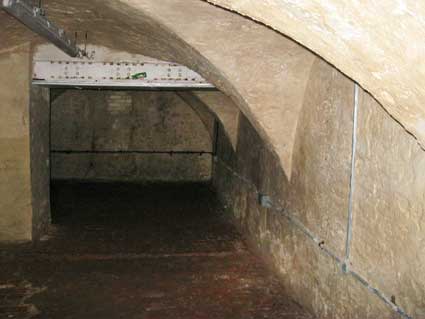
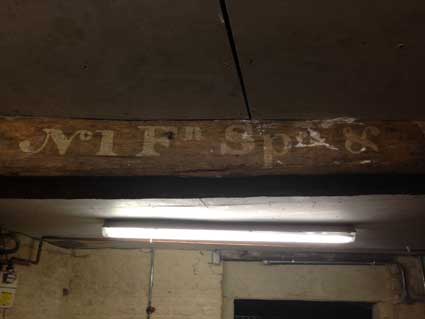 2014
images
2014
images
'No 1 Fn Sprs
&'
We think that this could date back to the days of the building
being run as an inn. Does it mean: 'Number 1 Fine Spirits & ...'?
Curson
House, Curson Plain
Curson Lodge should not
be confused with Curson House, built in 1500, which once stood on the
opposite corner. To quote the historian Lilian Redstone:
"Curson House with spacious parlours buillt round a courtyard at the
south-east corner of the present Silent Street and Rose Lane (then
Curson Lane) was the home of a Count of the Holy Roman Empire, Robert
styled 'Lord' Curson (c.1460-1534/5), who lived here in state with his
yeoman and
servants, his wife, Dame Margery, and her three gentlewomen, and two
chaplains to serve the chapel within the large garden." It is difficult
to imagine such a thing when one looks at the rather crowded,
semi-industrial Rose Lane today. The house was undoubtedly very grand
with a portico standing far out into the street (it is said that it was
tall enough for a horse riser to pass under it). The present-day
building on this site has retail units on the ground floor and is
called Curzon[sic] House. For a note about the great house's role as
"King's Hospital" and the probable source of the name Silent Street see
Street name derivations.
For a 1528 map of the area including Curson House and Lodge, see our Wolsey's College page.
Lord Robert Curson played a key role as witness and reporter of the
'miracles' at the shrine of Our Lady of Grace in 1516 (see the update
on our Lady Lane page). He played host to
Katherine of Aragon (1517), King Henry VIII (1522) and Cardinal Thomas
Wolsey at
Curson House, all attracted by the short-lived fame of the shrine.
Ironically, part of Wolsey's grandiose College scheme was to evict poor
Lord Curson from his house in St Nicholas Street and take it for his
own use. The very house where Curson had entertained the Maid of
Ipswich during the wonders of 1516. Curson's letter to Wolsey in the
summer of 1529 begs for compensatory lands and for three years grace
for him to find another house. [Blathchly, J: Miracles in Lady Lane, see Reading List] By keeping his head down Curson
managed to keep his house because of Wolsey's fall from grace and
subsequent death.
For a rooftop view of Curson
Lodge and Silent Street see our Sailors Rest
page.
This wider area of paving and roadway between
Curson Lodge and the Sailors Rest seems to have been named 'Curson
Plain' around the time of the installation of the Cardinal Wolsey Sculpture in 2011.
However, we haven't found a street nameplate to this effect.
Curson Lodge and Curson
House: historical perspective
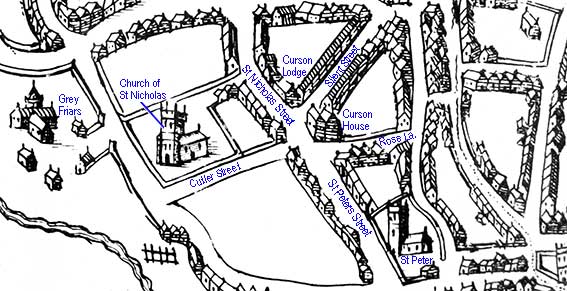 Detail
from 1610 map
Detail
from 1610 map
Above: this detail from John Speed's map –
the first reliable map of the town – shows Curson Lodge at the upper
centre and the Curson family house just south-east of it (where St
Nicholas
Street becomes St Peters Street). Curson Lodge itself was part of an
imposing architectural complex situated just north of the main trading
area of the docks and would have attracted visitors seeking
accommodation. As mentioned above, Curson House played host to a number
of distinguished and royal guests. Curson Lodge may not have been built
as such, but it is probable that the building was subsequently used by
Curson House for the accomodation of distinguished visitors. This would
reflect the arrangement in Soane Street where the Packhorse Inn acted
as a guest house (hospitia)
for Holy Trinity Priory. Secular inns are thought to have been first
licensed at some date after the dissolution of the monasteries, so
inn-keepers were required to provide lodgings for genuine travellers.
The most probable original purpose of Curson Lodge was as a medieval
inn (due to its partly-vaulted cellar with its own shute in the
roadway) and, if so, it is one of the finest and best preserved of its
kind. At one
time there was a two-storey projecting porch onto Silent Street, in
similar style to that on Curson House (as shown on the 1528 map on our Wolsey's College page), which would have
connected to
the main buildings via the position of a window in the former Claude
Cox bookshop.
It would seem likely that, post-dissolution, Curson House was given to
the Bishop of Norwich by King Edward VI to be used occasionally by
Bishop Wren (1635-1638). It appears that the bishop sublet much of the
house, keeping a few rooms for his personal use, as needed. From 1666
to around
1680 Curson House was used as a naval hospital, 'The
King's Hospital', for those
injured in the Anglo-Dutch Wars. (This has given rise to the mistaken
attribution of 'Silent' Street – see Street
name derivations.)
In 1760 the large porch of Curson House was demolished.
Robert Trotman, a merchant and malster and already a
tenant of the building, bought Curson House in 1799; he was six times
Bailiff of Ipswich and died in 1813. There was already a malting office
behind the porch in 1750 and the land behind was known as Elephant
Orchard, which may relate to the story that the building would become
the Elephant and Castle. Trotman eventually
turned the house into an inn and continued as an inn for most of the
19th
century. However, there is some confusion between Cursons House and
Lodge and the 'Elephant and Castle' name has also been
applied to the latter.
For much more information see Lord Robert, Lord Curson, soldier,
courtier, and spy, and his Ipswich mansion by John Blatchly
and Bill Haward (published by The Suffolk Institute of Archaeology and
History).
Curson Lodge is next heard of when John Conder bought it in the late
1770s. He continued the family business of leather-working in Curson
Lodge which continued there under Thomas Conder until 1836. 93 to
95 Fore Street – next door to Jackson's the chemist (later E.J. Owles) – had windows
bearing the lettering 'T.E. and J. Conder Limited , Leather Merchants
(established 1689)' in 1960, but it is not clear if they were still
trading. From 1836 William Silverston, a chemist, owned the property
and in 1858 he had bought another house adjacent to it. From 1868 John
Codgebrook was a beer retailer at no. 45 (sometimes known as St
Nicholas Ale Store), with Silverston at no. 47. By 1890 Wiggin &
Son had taken over the chemist's business in Curson Lodge. By 1894
the
beer retailer had closed and that property also acquired by Wiggin. In
the
20th century the corner shop sold antiques. The Building Preservation
Trust restored the buildings, completed in
2007. Curson Lodge is Listed Grade II*. [Information based on a paper by Charles
Tracy (IBPT), 2007]
'The Wolsey Gate',
College Street
The brick gateway is next to the churchyard of
St Peter.
Although it is all
that remains of the college founded by Cardinal Wolsey in 1528, the
shaping of the brick in the flanking piers and hood molding of the
panel over the doorway indicate in miniature the quality of workmanship
achieved under his patronage.

‘THIS GATEWAY
FORMERLY SERVED THE
SCHOOL FOUNDED BY
WOLSEY IN 1528 AS THE
CARDINAL’S COLLEGE OF SAINT MARY’
In the 16th century the Orwell river dock would have come up to
around three-quarters of the way across the width of today's College
Street from the gate. Thus, this is the water gate
of Wolsey's ill-fated college and it is the only part of
the grand scheme to survive. Sadly, it is in very poor condition
compared to photographs as recent as those taken in the 1920s. The
crest is
indecipherable now, the stone eaten away by industrial pollution and
weather.
Ironically, the much-more-recent plaque commemorating the gateway and
its importance is also disintegrating at an even faster rate. The coat
of arms to the left is that of Wolsey, chosen by him when he was made
Archbishop of York and a cardinal by Pope Leo X in 1514, with a chief
of two Cornish choughs either side of a Tudor rose (showing allegiance
to Henry VIII) and four leopard's heads around a lion passant below.
The 1785 engraving below shows the coat of arms of Henry VIII on the
only stone element of the gate,
although it is almost unrecognisable today due to erosion. In the 1820s
the Wolsey gate was described as: "... entirely of brick, worked into
niches, wreathed pinnacles, and chimneys, flowers, and other
decorations, according to the fashion of the times. At present it seems
nodding to its fall, being much out of the perpendicular." Once the
College had fallen, "Henry VIII was said to have taken offence to the
fact that Wolsey had placed his own arms above that of the king's on
the Gate House, and most of what occupied the six-acre site was 'razed
to the ground'... Although the Gate is said to have been the entrance
to the College, it is not likely that it was the main one so it will
never be known if, in fact, Wolsey had placed his arms above the king's
or whether this was just one of the many charges laid at the Cardinal's
door when he fell from favour." [Twinch, C.: Ipswich street by street, see Reading list] See our Wolsey's College page for
long-demolished Turret House, which could have been the main gatehouse
for visitors from the north.
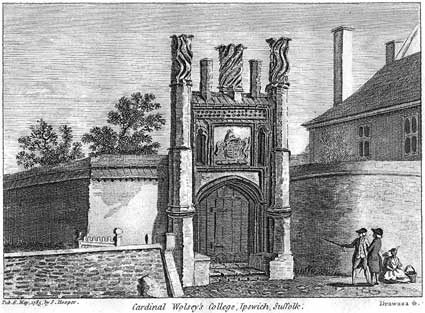 1785
1785
The 1785 engraving above shows the gate
closer to its original appearance; note the small gate to the left into
the churchyard of St Peter. Although this small gateway and wall
has been modified, the
brickwork wall around this area and passing behind the east of the
church still stands and is a registered historic monument (see our College Street page for photographs).
 2014 images
2014 images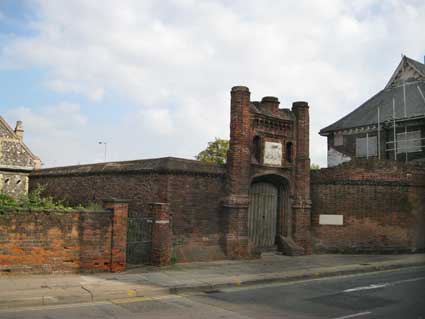
Robert Malster (see Reading
list)
points out that the thoroughfare composed of today's Salthouse Street,
Key Street and College Street (running in front of Wolsey's watergate)
would, in Wolsey's time, have been a riverside road, similar to
Wherstead Strand between Ipswich and Freston.
So we can estimate that the river quays were around three-quarters of
the way across today's College Street. Travellers could therefore
disembark from a vessel and take the short walk to the watergate into Wolsey's College
campus. In fact, there were a number of inlets off the main dock and
one of them was at today's Foundry Lane which is almost opposite
Wolsey's Gate; this fits with the Anglo-Saxon ford leaving the river
here, so a traditional access point to the ford would perhaps have
evolved into an inlet. Over the centuries, reclamation of land (and the
repeated dumping of ballast by loading trade vessels on the banks) made
the dock river progressively narrower until the building of the Wet
Dock in the 1830s.
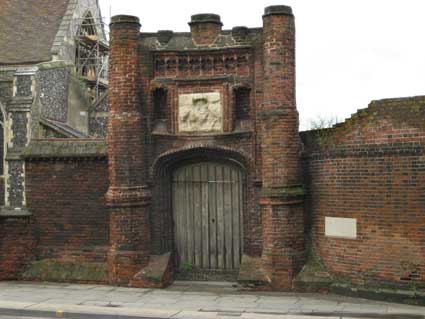
By the 21st
century the "wreathed pinnacles, and
chimneys" of the water gate are truncated and the stone eaten away.
Further images of the gate can be found on the College Street and Wolsey's College page. There is a small
copy of Wolsey's Gate at 'Annesley Hall' (built c. 1860), Boot Street,
Great Bealings (shown below); it's easy to flash past this on the
narrow but rather too busy
road.
 2014 image
2014 image
Perhaps not too surprisingly, Christopher Fleury's design for
the new Ipswich School, opened in 1852, incorporated a central
porch (and other window details particularly the pinnacles) echoing the
Wolsey Gate architecture, as for a brief couple of years 'Wolsey's
College' was 'Ipswich
School' (and vice versa).
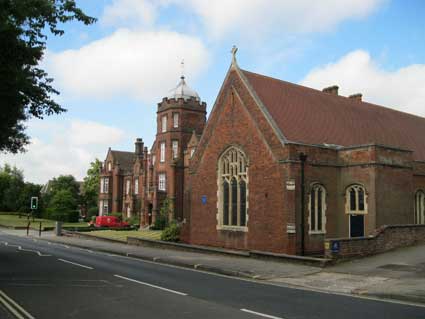
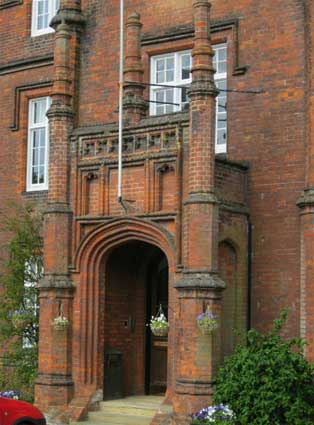 2014 images
2014 images
(See our Blue plaques page for the
Sherrington plaque on the school chapel.)
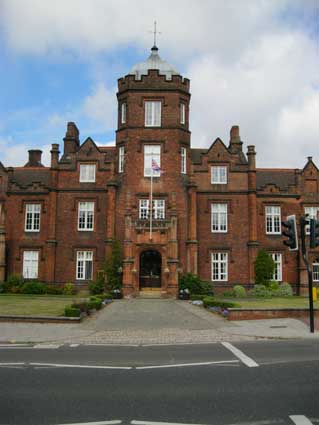
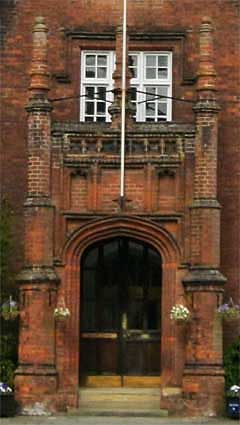
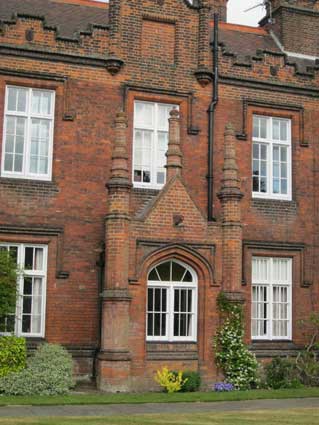
Cardinal
Thomas Wolsey, Henry VIII’s
Chancellor, established the
Cardinal College of St Mary the Virgin in his home town in 1528
incorporating the medieval Church of St Peter as its chapel. The
College buildings were never fully completed because Wolsey fell from
favour in
1530 and died on his way to London where he was due to go on trial.
After the Cardinal's death, Henry VIII seized all Wolsey’s assets,
including Hampton Court Palace and the
Ipswich College, and many of the materials were used by the King to
build
Whitehall Palace. The College was actually a school which had been
founded in
medieval times – Wolsey had wanted it to be a rival to Eton College –
and Ipswich School only survived through the intercession of Thomas
Cromwell (formerly Wolsey's right-hand man) and by returning to its
previous premises. Over the next few
centuries it occupied several different properties before it moved into
its current home in Henley Road as Ipswich School in 1852 (See
Blatchly, J: A famous antient
seed-plot of learning, Reading List). Wolsey’s
Gate was the watergate to the College. When it was
built (in the 1520s) the river came right up to where College Street is
now and the gate opened straight on to the river. It is in its original
position and has been well maintained in recent times, despite a deal
of
erosion of the stone carvings. If a strip of land were to be purchased,
the gateway might be incorporated in St
Peter's Church churchyard.
We have much more on the story of Wolsey's
College, with further pictures of the Wolsey Gate.
Home
Please email any comments
and contributions by clicking here.
Search Ipswich
Historic Lettering
©2004 Copyright
throughout the Ipswich
Historic Lettering site: Borin Van Loon
No reproduction of text or images without
express
written permission
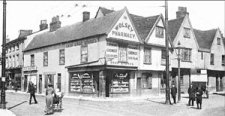

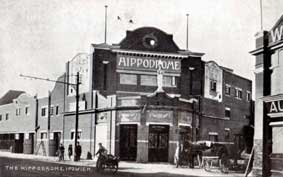
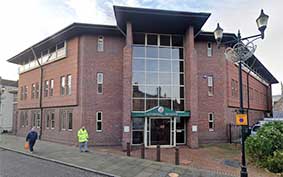
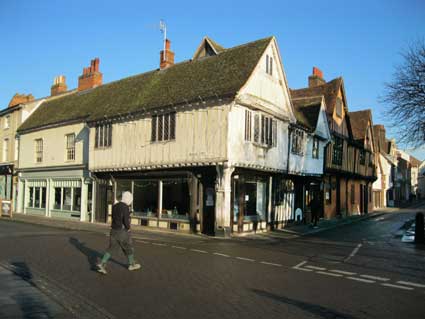
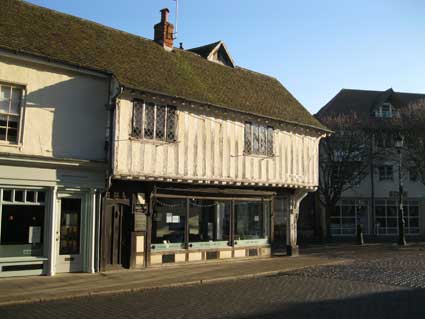 2013 images
2013 images Images courtesy John Barbrook
Images courtesy John Barbrook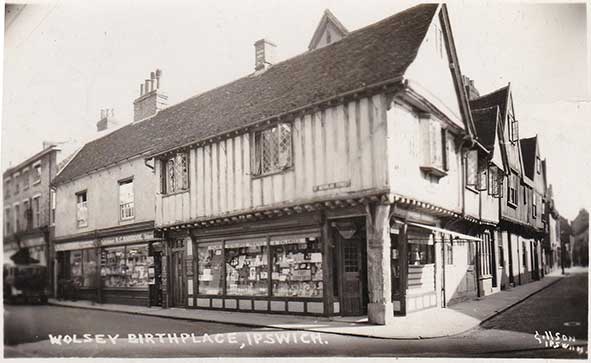 1930
image courtesy John Barbrook
1930
image courtesy John Barbrook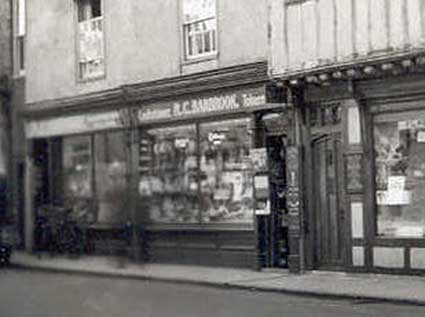


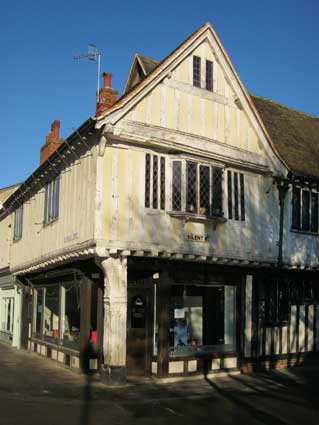 2013 images
2013 images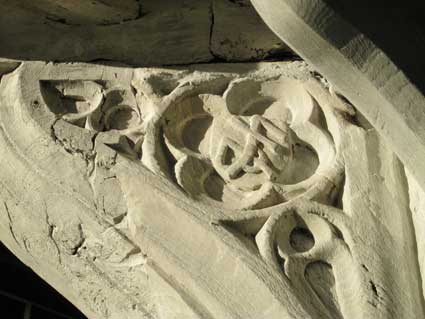

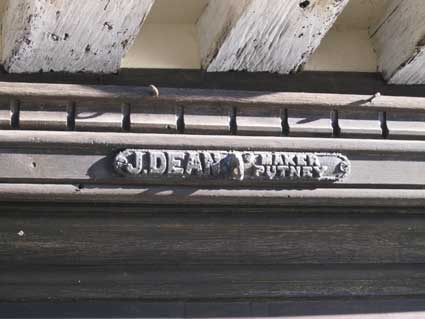

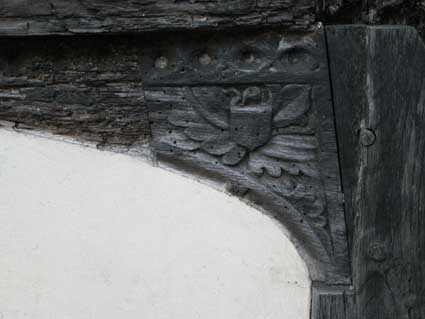
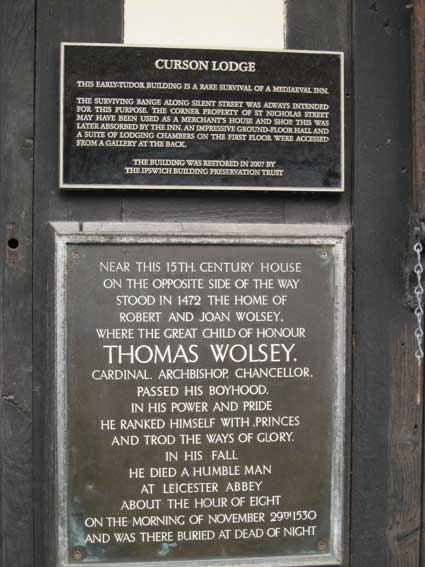

 2014
images
2014
images Detail
from 1610 map
Detail
from 1610 map
 1785
1785 2014 images
2014 images

 2014 image
2014 image
 2014 images
2014 images

